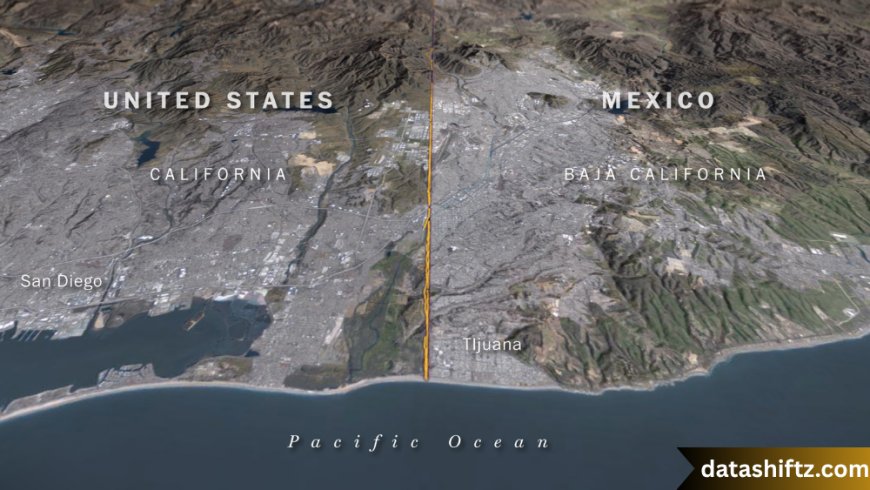The U.S.–Mexico Border: A Comprehensive Overview of Policy, History, and Human Impact

Introduction
The United States–Mexico border is one of the most politically and culturally significant boundaries in the world. Stretching over 1,954 miles (3,145 km), it spans diverse terrains—from the Pacific Ocean to the Gulf of Mexico—crossing deserts, rivers, mountains, and cities. But beyond its geography, the border represents a convergence of immigration policy, economic exchange, national security, and human rights.
Over the years, this border has evolved from a loosely monitored line to a highly fortified and politically charged zone. Debates surrounding the border wall, migrant caravans, asylum seekers, drug trafficking, economic interdependence, and cross-border culture continue to shape U.S. domestic and foreign policy.
This in-depth article delves into the history, current dynamics, security issues, immigration policies, and the sociopolitical implications of the U.S.–Mexico border. It also includes key statistics, tabular data, and helpful lists to provide a well-rounded perspective on this complex and ongoing issue.
Historical Background of the U.S.–Mexico Border
Origins of the Border
The U.S.–Mexico border was officially established in the mid-19th century. Following the Mexican–American War, the Treaty of Guadalupe Hidalgo (1848) ceded a large portion of Mexican territory (including California, Arizona, New Mexico, and Texas) to the U.S., establishing a formal boundary between the two nations.
Key milestones in border history:
-
1848 – Treaty of Guadalupe Hidalgo signed
-
1853 – Gadsden Purchase finalized, extending the southern parts of Arizona and New Mexico
-
1910s–1920s – Border checkpoints introduced amid immigration and security concerns
-
1990s – Operation Gatekeeper launched to curb illegal crossings near San Diego
Border’s Cultural and Economic Evolution
Despite political tensions, the U.S.–Mexico border has long been a zone of economic interdependence and cultural blending. Cities like Tijuana-San Diego and El Paso-Ciudad Juárez exemplify the binational character of border life—where families, workers, and traders move across daily for commerce, education, and kinship.
Geography and Demographics of the Border Region
States and Border Cities
The border passes through four U.S. states and six Mexican states:
| U.S. States | Mexican States |
|---|---|
| California | Baja California |
| Arizona | Sonora |
| New Mexico | Chihuahua |
| Texas | Coahuila, Nuevo León, Tamaulipas |
Key Border Cities:
| U.S. City | Mexican Counterpart |
|---|---|
| San Diego, CA | Tijuana, Baja California |
| El Paso, TX | Ciudad Juárez, Chihuahua |
| Laredo, TX | Nuevo Laredo, Tamaulipas |
| McAllen, TX | Reynosa, Tamaulipas |
| Brownsville, TX | Matamoros, Tamaulipas |
Population and Economic Integration
Border cities form a combined population of over 15 million people, many of whom live binational lives—commuting for work, school, or trade. Cross-border commerce is vital, with billions in goods moving through ports of entry each day.
Security and Border Enforcement
U.S. Border Patrol and Enforcement Agencies
The U.S. Customs and Border Protection (CBP) is the primary agency responsible for managing and securing the border. It includes:
-
U.S. Border Patrol (USBP) – Manages land areas between official ports of entry
-
Office of Field Operations (OFO) – Oversees ports of entry and cargo inspection
-
Air and Marine Operations (AMO) – Monitors air and sea regions
Border Security Statistics (2024)
| Metric | Value |
|---|---|
| Total Border Patrol Agents | ~19,500 |
| Migrants Apprehended | ~2.2 million (FY 2023) |
| Border Wall Constructed | ~720 miles |
| Official Ports of Entry | 48 |
| Daily Legal Crossings (avg.) | ~1 million people and vehicles |
Controversial Measures and Surveillance
Increased border enforcement has included:
-
Use of drones and ground sensors
-
Surveillance towers and thermal imaging
-
"Remain in Mexico" policies for asylum seekers
-
Family separations and detention centers
These strategies have sparked significant criticism from human rights organizations and immigration advocates.
Immigration and the Humanitarian Crisis
Migrant Caravans and Asylum Seekers
In recent years, migrant caravans—large groups of asylum seekers, mostly from Central America—have traveled on foot toward the U.S. border seeking protection from violence, poverty, and political instability.
Many migrants:
-
Apply for asylum under U.S. law
-
Wait in border cities like Tijuana or Matamoros
-
Live in temporary shelters for months or years
Humanitarian Challenges
Humanitarian concerns along the border include:
-
Deaths in the desert due to dehydration and extreme heat
-
Detention center conditions, especially for children
-
Overcrowded shelters on the Mexican side
-
Backlogs in immigration courts, delaying asylum rulings
The U.S.–Mexico Border Wall
Construction and Political Debate
One of the most controversial aspects of U.S. border policy is the border wall—a physical barrier intended to stop unauthorized crossings. Although portions of the wall have existed since the 1990s, its expansion became a major political issue during President Donald Trump’s administration.
Key Facts About the Border Wall
-
Length: Approximately 720 miles of barriers currently in place.
-
Funding: Over $15 billion allocated between 2017 and 2020.
-
Effectiveness: Debated—some say it deters illegal entry; others cite tunnels, ladders, and water routes.
-
Environmental Impact: Disruption of wildlife migration and border ecosystems.
-
Legal Challenges: Land seizures and eminent domain lawsuits still pending.
Trade and Economic Relations Across the Border
U.S.–Mexico Economic Ties
The border is not just a line of separation—it is a critical trade artery. Under the United States–Mexico–Canada Agreement (USMCA), hundreds of billions of dollars flow annually through ports of entry.
Cross-Border Trade Highlights (2024)
| Category | Trade Volume |
|---|---|
| Total U.S.–Mexico Trade | Over $780 billion annually |
| U.S. Exports to Mexico | $320 billion |
| U.S. Imports from Mexico | $460 billion |
| Key Sectors | Automotive, agriculture, electronics, textiles |
Impact on Local Economies
Border cities benefit from:
-
Maquiladoras – Manufacturing plants operating under favorable tax laws
-
Tourism – Cross-border shopping, dental care, and entertainment
-
Labor markets – Shared employment opportunities and skilled labor exchanges
The Human Element: Life on the Border
Binational Communities
Life on the border often defies the divisive narratives presented in politics. Many people live interconnected lives:
-
Children born in one country, raised in another
-
Families divided by immigration status
-
Students who cross daily for school
-
Dual citizens managing cross-border businesses
Realities of Living on the U.S.–Mexico Border
-
Bicultural identities are common.
-
Residents often speak both English and Spanish.
-
Healthcare and education access varies drastically.
-
Legal crossings are part of daily life.
-
Fear of raids or detentions affects many mixed-status families.
Policy Shifts and Future Directions
Recent U.S. Administrations’ Approaches
| Administration | Key Border Policy Measures |
|---|---|
| Obama (2009–2017) | DACA implemented; record deportations |
| Trump (2017–2021) | Family separations; border wall expansion; "Remain in Mexico" |
| Biden (2021–Present) | Ended family separations; struggled with surge in border crossings |
The Path Ahead
Moving forward, border policy must strike a balance between:
-
National security and human rights
-
Economic cooperation and regulatory enforcement
-
Legal immigration reform and asylum protections
Conclusion
The U.S.–Mexico border is more than just a boundary—it is a symbol of division and connection, of conflict and cooperation. It encapsulates the complexities of modern immigration, security, economics, and cultural identity. As policymakers, activists, and citizens continue to debate the future of this boundary, the lives of millions hang in the balance.
Understanding the nuanced reality of the border is crucial. It's not just a wall or a line on a map—it is a dynamic ecosystem of people, policies, and shared destinies.





























